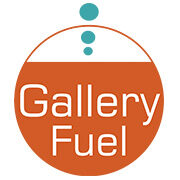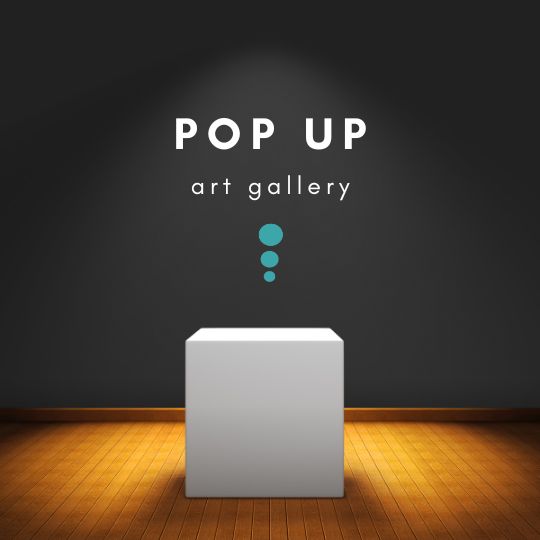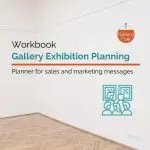The pop-up art gallery remains a popular strategy for art gallery businesses to expand brand awareness, grow their market and collector base, and introduce their artists to new audiences. Successful execution requires extensive planning, but when done well, the benefits can extend long after the pop-up concludes.
To make the most of a pop-up gallery, you need to get four key elements right.
- Clear Goals
- Location
- Advertising
- Collector Follow-up
Let’s look at these four success factors in more detail.
Defining Your Pop-up Art Gallery Goals
Pop-up art galleries are a chance to energize your gallery, attract new collectors, and put your artists in the spotlight in fresh ways. Because the window is short, planning with clear goals is key. Knowing what you want to achieve allows you to design every detail from the artwork on display to the visitor experience. You’re going for a big impact for your artists and prospective buyers – and hopefully your gallery’s brand too.
As you outline your goals, consider these. Some may be more appropriate for a first-time popper, and others for after you have some experience under your belt.
Art Sales & Revenue
Set a clear goal to drive sales during the pop-up by leveraging its limited-time nature to create urgency. Use the event to test the market for specific artists, styles, or price points, gathering insights on which works resonate most with buyers and adjusting future offerings accordingly.
Attracting New Art Collectors
Aim to expand your collector base by attracting individuals who might not typically visit your gallery. Capture contact information, engage new demographics, and cultivate relationships that can grow into long-term collectors beyond the pop-up’s duration.
Brand Awareness
Use the pop-up to increase visibility and strengthen your gallery’s brand identity. Position your program as approachable, innovative, and culturally engaged, reinforcing your reputation as a tastemaker while reaching audiences in high-traffic or unexpected locations.
Exposure for Gallery’s Artist Roster
Focus on giving your artists meaningful exposure to new audiences. Provide opportunities for both emerging and established artists to experiment with exhibition formats that may not fit your main gallery program, helping them expand their reach and build their profiles.
Community & Partnerships
Set goals around building local connections by collaborating with businesses, cultural institutions, or nonprofits. These partnerships can amplify promotion, make art more accessible to the community, and lay the foundation for ongoing collaborations beyond the pop-up.
Experience Creation
Prioritize creating memorable, immersive experiences that engage visitors on multiple levels. Use the temporary nature of the event to generate excitement and exclusivity, encouraging deeper engagement and social sharing that extends the gallery’s reach well beyond the attendees.
While all these goals may sound appealing, I recommend you focus on one or two primary objectives that aligns most closely with your gallery’s current needs and long-term strategy. Trying to achieve too many goals at once can dilute your efforts and reduce the overall impact of the pop-up.
Your chosen goal should act as the foundation for every decision you make. For example, if your goal is to find new collectors, you might prioritize a location with high foot traffic and invest in targeted advertising to attract the right audience. If your goal is to test a new market, you’ll want to select a location that reflects the demographics and preferences of that area. Similarly, your communication strategy—both during and after your pop-up—should be tailored to reinforce your goals. This helps ensure that the connections you make during the pop-up translate into lasting opportunities for your gallery.
Finding a Location for Your Pop-up Gallery
With your goals clearly defined, it’s time to start searching for the perfect pop-up location. Consider any resources you may already have in various cities that align with your gallery’s objectives. For instance, do you already know any realtors or business owners who might benefit from collaborating with your gallery on a short-term pop-up? Do you have contacts with contractors who can help prepare the chosen space?
Partnering with an existing business or another gallery offers many advantages, as they already have a space and a customer base. Choose a partner with similar patrons who appreciate luxury and beauty, such as a boutique jewelry store, interior design or architecture firm, luxury car dealership, boutique hotel, resort or high-end wine shop or winery.
If leveraging existing relationships is not an option, consider reaching out to residential or commercial real estate agents. Write up a proposal outlining what you hope to achieve and how it could benefit them to collaborate with you.
Advantages of Residential Pop-ups
Residential locations are budget-friendly and create a more intimate event atmosphere, although the availability of the home may be limited. Listing agents can use the pop-up to market the home and invite past clients to a unique event, expressing gratitude for their business and maintaining top-of-mind awareness. Ensure you can attract the right audience to a residential location.
Advantages of Commercial Pop-ups
Commercial real estate properties, such as storefronts, offer greater flexibility in the duration of your pop-up gallery and how you can design the space. If chosen wisely, your gallery should benefit from good foot traffic in a commercial area. Commercial listings gain by collecting some rent (which is negotiable) on the vacant property and showcasing their location as a usable space. Another benefit for them is if you agree to perform some cleanup work in exchange for reduced rent.
There are additional options for finding a great location for your pop-up gallery. The type of space you choose should be directly tied to your goals. Consider using online platforms to find the perfect space for your pop-up gallery. Platforms like Peerspace offer hourly or daily rentals of creative spaces, while Storefront specializes in short-term retail and gallery spaces. Additionally, Popupshops provides global listings of pop-up venues for art galleries. These platforms allow you to filter options by location, size, amenities, and rental terms, making it easier to find a space that aligns with your art gallery’s goals and needs.
Think outside the box when it comes to the space you select. It could be part of the draw for your target audience.
Budget Planning for Your Pop-up Gallery
As part of your planning process, consider how you will encourage visitors to hand over their contact information so you can add them to your database and follow up after the pop-up closes. Do more than put out a guest book. After all, the opportunity to attract new art collectors is limited to the length of your pop-up, so make the most of it. Find some incentives both before and during the time you will be in this location, such as a raffle to win a piece of artwork or a photo booth where photos get emailed afterwards.
Obviously, the budget will factor in on how big your gallery can pop. You don’t need to spend a lot of money to have an impact. There are many creative and inexpensive ways to create a pop-up gallery. If your art gallery decides to go with a commercial rental space, consider the rent as a big chunk of your budget. But don’t be afraid to negotiate or barter to help with those costs.
Other Budget considerations include:
- Utilities
- Lighting
- Cleaning and/or paint supplies
- Staff
- Internet access
- Insurance
- Security
- Permits
- Travel
- Signage
- Marketing
- Inventory transportation
- Furniture
- Reception catering
Today, there are companies that offer retail spaces in big art markets specifically for a pop-up art gallery. Most of your needs are taken care of by them, and there are fewer budget surprises.
Advertising Your Pop-up Gallery
Effective advertising is critical to the success of a pop-up art gallery, especially if you are entering a new market. Start by developing a comprehensive marketing plan well in advance—ideally 6–8 weeks before your opening—to build awareness and generate excitement.
If you are collaborating with another business, coordinate your marketing efforts from the beginning. Share all key details, including images, artist information, and event dates, so your partner can feature your gallery in their website content, social media posts, and newsletters. Provide this information well ahead of time to ensure their audience has multiple opportunities to engage. Make it easy for them to communicate exactly what visitors can expect and when they can experience your artwork.
If you are launching on your own, start teasing your gallery even before you finalize a location. Locally targeted social media campaigns, including ads and boosted posts, are a powerful way to introduce your gallery to a new audience. Share behind-the-scenes content, sneak peeks of the artwork, or concept sketches to spark curiosity and create anticipation.
Local Media & Community Outreach
Explore local advertising opportunities, including community event calendars, lifestyle publications, neighborhood newsletters, and collaborations with bloggers and journalists. Obviously – Wait until all details, such as dates, location, and participating artists, are finalized before submitting press releases to ensure accurate coverage, but start early building your local PR list for your target market. Pitch feature stories that showcase the gallery’s unique concept, highlight the artists, or emphasize its community impact. Don’t forget to also leverage geotargeted social media ads to connect with locals and the surrounding area.
Try to maintain consistent messaging throughout your campaign, focusing on the exclusivity and limited-time nature of your pop-up to create a sense of urgency and drive attendance.
On-site Promotion
If your pop-up is located in a retail space with foot traffic, why not capitalize on that visibility! A “Coming Soon” banner or window display can pique interest and attract passersby even before your doors officially open. To take it even further, window signage is a great place to include a QR code linking to your website or email sign-up page to capture leads early.
After Your Pop-up
Once your temporary pop-up gallery has closed and you return to your regular space, you must continue to nurture the new leads you acquired. Nurturing those who visited your pop-up is where you have great revenue potential for years to come. A follow-up strategy should be planned in advance. You want to immediately start forming solid relationships with the art collectors you connected with. Here are some ideas for putting together a follow-up process. Mastering the Follow-Up for Art Gallery Sales Leads
Finally, review the goals you set out to achieve and the final budget to determine how successful it was as a business strategy. What could you have done better? What lessons were learned from advertising and location choice? Can your efforts be duplicated in another market? It’s smart to document what went well and what needs improvement. This makes it easier for your next pop-up gallery.
To the Point
There are so many reasons a pop-up art gallery could be good for your art gallery business, and there are no limits to how you can do it. The scariest part is the planning of the first one. To make that easier, keep your goals specific and straightforward. Choose a location that offers your business something your current location may lack.
Don’t push the timeline to be too short for due diligence on location, resources, and marketing potential. These are all elements of your pop-up gallery that need to be done well to be profitable. Use the opportunity to take some risks and step outside your comfort zone. You never know which of those risks will pay off tenfold.
Check out these articles too
5 ways to increase foot traffic in an art gallery
Planning and Preparing Your Gallery for Art Fair Success
Art Gallery Business Development Priorities
Art Gallery Exhibition Planning Workbook




Interested in Pop Up Gallery for Briana Re’Nee Art Gallery. Briana Re’Nee Johnson has been drawing, painting and writing stories since the tender age of 3. She has copyrights. Plenty of Briana Renee Johnson’s cultural hand drawings are being illustrated in children books. However her explicit drawings and paintings are for exhibition only. Limited prints will be for sale as well as merchandise and souvenirs.
Hello Helen,
Thank you for your comment. I’m happy to speak with you if you have questions about how to create a pop-up for Briana Re’Nee Art Gallery.